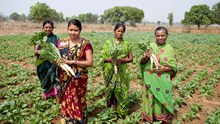
Kharif sowing in India has picked up pace this season, with the total area sown reaching 89.29 lakh hectares as of June 13, 2025. This marks an increase of 1.48 lakh hectares compared to the same period last year, indicating a positive start to the agricultural season. The increase is largely driven by higher acreage in rice, pulses, and oilseeds, according to the latest data released by the Ministry of Agriculture.
Rice cultivation has seen a significant rise, with 453,000 hectares already covered, up from 400,000 hectares in 2024. This 13 percent increase reflects favorable conditions and possibly improved market sentiment.
Pulses have also experienced healthy growth in sowing, reaching 307,000 hectares, which is 18 percent higher than last year's 260,000 hectares. Moong and urad have shown significant gains, although arhar has declined slightly. This mixed trend in pulse crops suggests changing farmer preferences and variations in regional weather.
The oilseeds segment has shown promising growth, expanding to 205,000 hectares from 150,000 hectares last year. Soybean has been the primary contributor, responsible for most of the increase with an additional 66,000 hectares.
However, groundnut sowing has seen a marginal decline. Coarse cereals have remained relatively stable at 589,000 hectares, with bajra and jowar showing gains, while maize, ragi, and small millets have experienced some reduction in area. This segment's performance is crucial for food security, especially in rainfed regions.
Sugarcane coverage has risen marginally to 55.07 lakh hectares from 54.87 lakh hectares, maintaining its lead as the top contributor in terms of total acreage among Kharif crops. On the other hand, jute and mesta sowing has declined to 5.48 lakh hectares, while cotton has also dipped slightly to 13.19 lakh hectares.
The overall increase in sowing area reflects a cautiously optimistic outlook among farmers, likely influenced by early monsoon showers and timely preparations. As the season progresses, all eyes will remain on rainfall distribution and its impact on the next phases of Kharif sowing and crop health across the country.
















